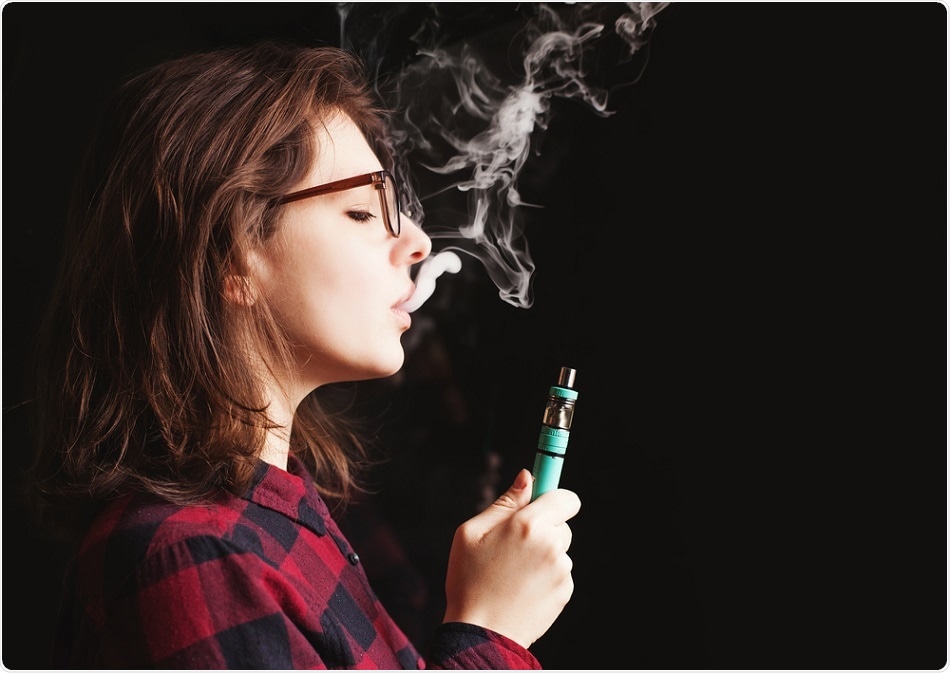A shocking new report shows that in just two years, the number of students in grades 8, 10 and 12 who use e-cigarettes has more than doubled, raising the already high stakes for public health workers. This is the horrifying conclusion of the Monitoring the Future Survey (2019), carried out by University of Michigan researchers.
 Mila Supinskaya Glashchenko / Shutterstock
Mila Supinskaya Glashchenko / Shutterstock
These results, which were published online in a letter in The New England Journal of Medicine (NEJM), appear even bleaker when viewed against the increasing medical evidence that vaping is addictive and hazardous to health. This includes the recent spate of hospitalizations and even deaths related to acute vaping-linked lung injury. Many other researchers have reported the presence of potential carcinogens at incredibly high concentrations in the flavoring agents used in e-cigarette liquid.
The national survey was intended to identify the extent of the continuing rise in adolescent vaping rates from 2018 to 2019. The researchers asked over 43,000 students in these grades, whether they had vaped in the past month. They elicited answers from 88% of students in grade 8, 86% in grade 10 and 80% in grade 12. They found that more than 1 in 11, 1 in 5, and 1 in 4 students had vaped once or more over the past month.
Calling the situation “a public health crisis,” National Institute on Drug Abuse (NIDA) Director Nora D. Volkow says, “These products introduce the highly addictive chemical nicotine to these young people and their developing brains, and I fear we are only beginning to learn the possible health risks and outcomes for youth.”
Vaping means the use of an e-cigarette to inhale an aerosol of heated gases obtained by vaporizing a nicotine-based liquid. The previous year (2017-18) saw the single largest rise in teenage vaping from 11% to 21% in grade 12, 8% to 16% in grade 10, and 3.5% to 6% in grade 8. This is the largest recorded increase in the use of any substance since this survey began 44 years ago.
In the present year, the previous-month vaping stats went up from 21% to 25% in grade 12, while in the other two grades it increased to 20% and 9%, respectively. The percentage of students who vape daily now stands at 12% in grade 12, 7% in grade 10 and 2% in grade 8. There is also a surge in the number of students who have ever vaped and those who have vaped once or more over the past year. Over two years, ever-vapers in grades 10 and 12 increased from 25% and 21% to a very high 40% and 36%, respectively. Those who vaped over the last 12 months increased from 19% and 16% to 31% and 35% in grades 10 and 12, respectively.
The upsurge in teenage vaping is further fueled by the attractive shapes and colors of the e-cigarettes, built to resemble catchy gadgets like USB drives, and flavored to taste sweet, fruity, minty or other flavors. Not only are these youngsters exposed to a host of potentially dangerous chemicals that have largely been untested as to their effects on the airways and lungs, but they are prime targets for nicotine addiction.
The significantly high rate of daily vaping suggests that many of these students have already become addicted to nicotine, a very strongly addictive and toxic chemical. Dependency in this area is very hard to overcome as past addiction research shows abundantly. The health effects of nicotine are multiple and can be deadly.
Researchers called on both parents and leaders to put programs in place to keep these products out of the hands of teens. Schools, c-cigarette manufacturers and government agencies have been trying to prevent teenagers from vaping, but with poor results, as shown by the survey results.
New efforts are needed to protect youth from using nicotine during adolescence, when the developing brain is particularly susceptible to permanent changes from nicotine use4 and when almost all nicotine addiction is established.”
University of Michigan researchers
The data was published on September 18, 2019.
Journal reference:
Richard Miech, Lloyd Johnston, Patrick M. O’Malley, Jerald G. Bachman, & Megan E. Patrick. Trends in Adolescent Vaping, 2017–2019. The New England Journal of Medicine. DOI: 10.1056/NEJMc1910739